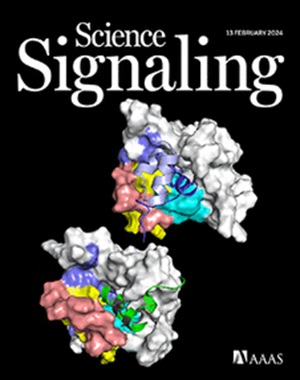lncRNA EPIC1抑制dsrna诱导的I型IFN信号,是增强TNBC对PD-1抑制反应的治疗靶点
IF 6.6
1区 生物学
Q1 BIOCHEMISTRY & MOLECULAR BIOLOGY
引用次数: 0
摘要
在各种类型的癌细胞中,逆转录元件衍生的双链rna (dsRNAs)的增加促进了抗肿瘤免疫反应的激活。长链非编码RNA EPIC1与组蛋白甲基转移酶EZH2相互作用,有助于肿瘤免疫逃避。在这里,我们发现肿瘤细胞中的EPIC1抑制细胞质dsRNA积累、I型干扰素(IFN)反应和抗肿瘤免疫。在各种癌细胞系中,敲低EPIC1刺激逆转录元件产生dsRNA和激活免疫细胞的抗病毒样I型IFN反应。EPIC1抑制LINE、SINE和LTR逆转录因子的表达,这些逆转录因子也被EZH2抑制,这表明EPIC1-EZH2相互作用可能在调节dsRNA产生中起潜在作用。在人源化小鼠模型中,体内递送靶向epic1的寡核苷酸可增强乳腺癌异种移植物中的dsRNA积累,降低肿瘤生长,并增加T细胞和炎性巨噬细胞对肿瘤的浸润。此外,在人源化小鼠模型中,EPIC1敲低提高了免疫治疗药物pembrolizumab(一种PD-1抑制剂)的治疗效果。总之,我们的研究结果确定了EPIC1是dsrna介导的I型IFN反应的关键调节因子,并强调了其作为提高免疫治疗疗效的治疗靶点的潜力。本文章由计算机程序翻译,如有差异,请以英文原文为准。
The lncRNA EPIC1 suppresses dsRNA-induced type I IFN signaling and is a therapeutic target to enhance TNBC response to PD-1 inhibition
Increases in retroelement-derived double-stranded RNAs (dsRNAs) in various types of cancer cells facilitate the activation of antitumor immune responses. The long noncoding RNA EPIC1 interacts with the histone methyltransferase EZH2 and contributes to tumor immune evasion. Here, we found that EPIC1 in tumor cells suppressed cytoplasmic dsRNA accumulation, type I interferon (IFN) responses, and antitumor immunity. In various cancer cell lines, knockdown of EPIC1 stimulated the production of dsRNA from retroelements and an antiviral-like type I IFN response that activated immune cells. EPIC1 inhibited the expression of LINE, SINE, and LTR retroelements that were also repressed by EZH2, suggesting a potential role for the EPIC1-EZH2 interaction in regulating dsRNA production. In a humanized mouse model, in vivo delivery of EPIC1-targeting oligonucleotides enhanced dsRNA accumulation in breast cancer xenografts, reduced tumor growth, and increased the infiltration of T cells and inflammatory macrophages into tumors. Furthermore, EPIC1 knockdown improved the therapeutic efficacy of the immunotherapy drug pembrolizumab, a PD-1 inhibitor, in the humanized mouse model. Together, our findings establish EPIC1 as a key regulator of dsRNA-mediated type I IFN responses and highlight its potential as a therapeutic target to improve the efficacy of immunotherapy.
求助全文
通过发布文献求助,成功后即可免费获取论文全文。
去求助
来源期刊

Science Signaling
BIOCHEMISTRY & MOLECULAR BIOLOGY-CELL BIOLOGY
CiteScore
9.50
自引率
0.00%
发文量
148
审稿时长
3-8 weeks
期刊介绍:
"Science Signaling" is a reputable, peer-reviewed journal dedicated to the exploration of cell communication mechanisms, offering a comprehensive view of the intricate processes that govern cellular regulation. This journal, published weekly online by the American Association for the Advancement of Science (AAAS), is a go-to resource for the latest research in cell signaling and its various facets.
The journal's scope encompasses a broad range of topics, including the study of signaling networks, synthetic biology, systems biology, and the application of these findings in drug discovery. It also delves into the computational and modeling aspects of regulatory pathways, providing insights into how cells communicate and respond to their environment.
In addition to publishing full-length articles that report on groundbreaking research, "Science Signaling" also features reviews that synthesize current knowledge in the field, focus articles that highlight specific areas of interest, and editor-written highlights that draw attention to particularly significant studies. This mix of content ensures that the journal serves as a valuable resource for both researchers and professionals looking to stay abreast of the latest advancements in cell communication science.
 求助内容:
求助内容: 应助结果提醒方式:
应助结果提醒方式:


